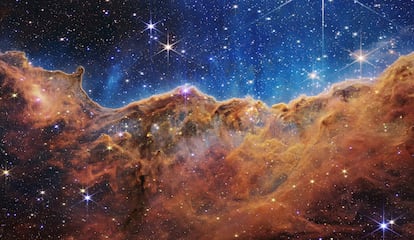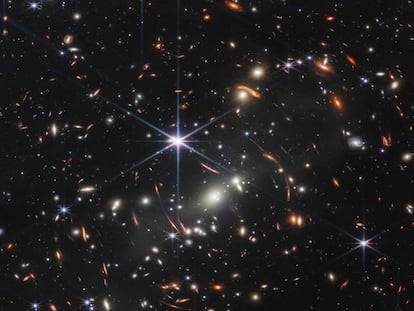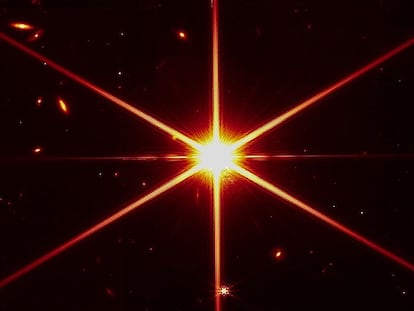James Webb space telescope: Where are the cosmic objects captured in the first images?
A planet known as WASP 96B is the closest to Earth, while the galaxy cluster Stephan’s Quintet is located 300 million light-years away

The James Webb space telescope can only observe 40% of the sky. It is the size of a tennis court, and moving it to point in a different direction is very difficult. Before it is moved, it must keep its back to the Sun. Its equipment must always be kept at a very low temperature, meaning it cannot be pointed at any site at any time. What it can do is rotate a complete turn on its axis to observe objects that are towards the north or south pole.
To study objects outside this field, researchers must wait months or even half a year until the movement of the Earth has dragged the James Webb to the other end of its orbit and the Sun occupies the opposite side.
These considerations have undoubtedly influenced what has been captured in the space telescope’s first photographs. Five of the six images are located in the southern hemisphere and therefore cannot be seen from Europe. Only Stephan’s Quintet, in the Pegasus constellation, is visible from Europe, although a good telescope is needed to see it.
Of the five objects, the closest to Earth is WASP 96B, a planet located 1,000 light-years away. To put this in context, the closest star to Earth is Proxima Centauri, which is four light-years away.
Located 2,000 light-years away is NGC 3132, a close neighbor in our “galactic neighborhood” in the Vela constellation. Technically, it’s a “planetary nebula,” but that name has nothing to do with planets. It looks like a colored ring, but it is actually the remains of an exploded star, a bubble of gas that continues to swell like a huge soap bubble. It is half a light-year across and is continuing to grow.
The impressive Carina Nebula is also a relatively close object. It is 8,000 light-years from Earth that appears as a large cloud of gas in the spiral of the Milky Way. The Carina Nebula spans 300 light-years, meaning only a part of it has been captured in the photo from the James Webb.
Stephan’s Quintet is in another league. It is made up of five galaxies: four, about 300 million light-years away, are united by their gravitational attraction, which has deformed them and created spiral arms of stars. The James Webb image shows the compact galaxy group as it appeared 4.6 billion years ago, when trilobites swam in the Earth’s oceans and the dinosaurs had not yet appeared. The fifth galaxy is just 40 million light years away, and if it is seen next to the others, it is only due to a perspective effect.
The image that US President Joe Biden presented on Monday, hailed as the deepest view yet into our universe’s past, captures thousands of early galaxies. One of the galaxies, which looks like a faint red dot, appears as it did 13 billion years ago. The galaxies seen as arcs of light are about 5 billion light-years away, in Volans, another constellation in the southern hemisphere.
Tu suscripción se está usando en otro dispositivo
¿Quieres añadir otro usuario a tu suscripción?
Si continúas leyendo en este dispositivo, no se podrá leer en el otro.
FlechaTu suscripción se está usando en otro dispositivo y solo puedes acceder a EL PAÍS desde un dispositivo a la vez.
Si quieres compartir tu cuenta, cambia tu suscripción a la modalidad Premium, así podrás añadir otro usuario. Cada uno accederá con su propia cuenta de email, lo que os permitirá personalizar vuestra experiencia en EL PAÍS.
¿Tienes una suscripción de empresa? Accede aquí para contratar más cuentas.
En el caso de no saber quién está usando tu cuenta, te recomendamos cambiar tu contraseña aquí.
Si decides continuar compartiendo tu cuenta, este mensaje se mostrará en tu dispositivo y en el de la otra persona que está usando tu cuenta de forma indefinida, afectando a tu experiencia de lectura. Puedes consultar aquí los términos y condiciones de la suscripción digital.











































